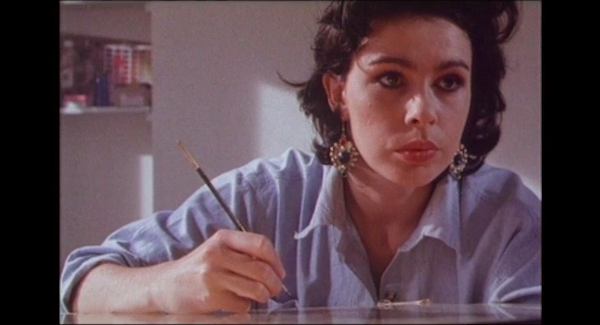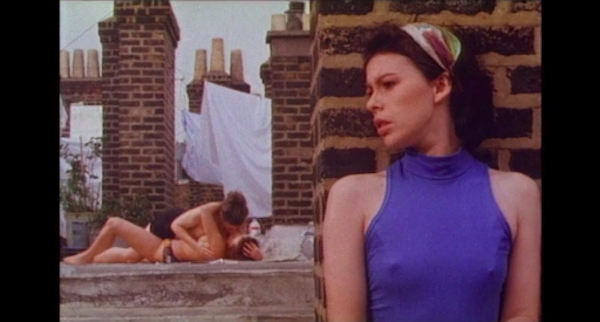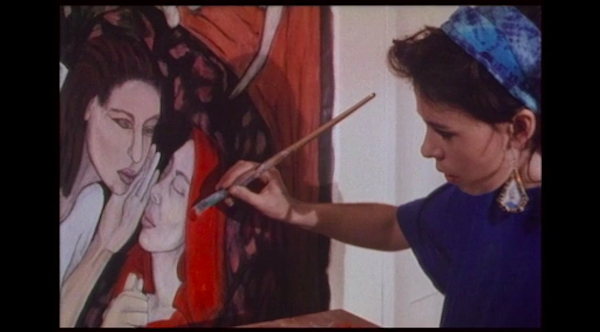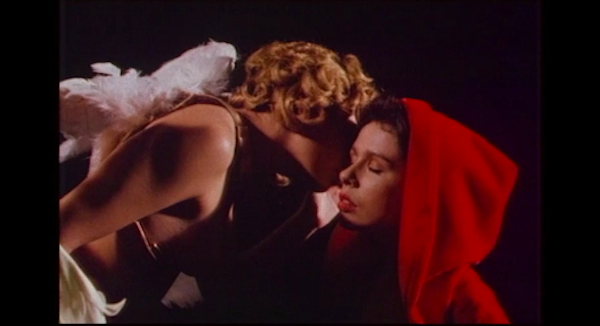Thirty years ago, a modest short film called Rosebud premiered on Channel 4 without making a sound. Today, coming to terms with her own queer identity through the pop culture that got her there, Lilia Pavin-Franks writes on its beguiling sensuality and the essential need for archival curation in order to preserve history.
What guides the brush when we begin to paint ourselves? Philosopher and gender theorist Judith Butler stated that “we lose ourselves in what we read only to return to ourselves transformed, and part of a more expansive world”. From the experience of so many young queer people, myself included, perhaps the same can be said for the intricate and symbiotic relationship between identity and pop culture.
In 1989, Channel 4 launched Out On Tuesdays, the world’s first networked TV series aimed at LGBTQ+ audiences. Originally airing at 11pm on Tuesday nights, Out offered a response to the demand from queer communities to have more access to the airwaves. In a conversation with Rebecca Dobbs published in Critical Studies in Television, Caroline Spry, commissioning editor at Channel 4 from 1985 to 1995, attests to the calls for LGBTQ+ inclusive spaces on national television noting that, at that time, “Gay representation was extremely low, and overwhelmingly negative.” With Out On Tuesdays, Spry and Channel 4 initiated a space for content made by queer broadcasters for queer audiences. A culmination of work from filmmakers, journalists, activists and the queer community itself, Out took on a magazine format, with several linked items in each programme largely driven by pop culture, and ran until 1994.
Amidst this landmark programming was Cheryl Farthing’s short film Rosebud. A film that, to the internet’s knowledge, only ever appeared on British TV once in 1991. The 13-minute short features Julie Graham as an unnamed artist, a shy wallflower who moves into a new flat and is quickly beguiled by the stylish lesbian couple next door. Beyond its demure debut, Rosebud was featured in Daisy Asquith’s Queerama, a documentary charting the history of gay representation on British screens using archival footage from the British Film Institute, and is now available to watch on BFI Player. But from the very sparse reactions to the film online, it seems that it was virtually impossible to get hold of it between 1991 and the late 2010s.
When I discovered Rosebud on BFI Player, it seemed to be at the most fitting time. Not only did 2021 mark the 30th anniversary of the film’s single showing on national TV, but It’s A Sin, Russell T Davies’ groundbreaking drama about the AIDS crisis, had just premiered on Channel 4. Having recently become acquainted with the history of queer broadcasting on Channel 4, the idea of 21st-century landmark programming formed a fitting parallel with this newfound knowledge of the world’s first networked TV series aimed at LGBTQ+ audiences. 30-odd years prior, queer programming was being cornered into the dark crevices of graveyard hours, but now proudly took the primetime slot. It felt like a privilege to see a TV show like this on screen, reminding me of the luxury of pop culture as history and its place within archival curation – without which I never would have discovered Rosebud.
Rosebud and Out On Tuesdays encouraged me to reflect on and realise the immense impact that pop culture has had on the trajectory of my own queer becoming. In the YouTube comments of a rare uploaded episode of Out On Tuesdays, watchers reminisce on the reassurance this show provided them with in their youth. One notes how it “made [them] feel a part of a wider world which was not apparent at the time”. Distilled to its essence, Out speaks to the importance of seeing and of being seen – of simply being reassured that you’re not alone. I am reminded of Santana having meaningful relationships with men and women in Glee and how, at 13, I’d never seen anything like it before.
In Rosebud, The Artist, like so many of us, starts to configure her sense of self through her connection to artistic means. Art creates a dizzying sense of physicality, at once reactive and sensory – and when you are creating with your own hands, it’s corporeal. Through the tangible connection to her paintings, The Artist is able to reconfigure her emotions and channel them into something she can make sense of. Her paintings allow her to visualise a side of herself that she had pushed aside, giving her room to experiment and test out sexual fluidity until she feels ready to do so physically; she forges a sense familiarity by imagining her and the women next door as kissing angels in her art, the terror of the unknown dissipating afterwards.
From her flat, The Artist shyly meets the eyes of the female couple, who have just returned from a night out at the gay club Rosebud. Swiftly tearing down the frills lining the window, she clears her space of outdated aesthetics, and with it, takes action against the negative “curtain twitching” notions of the women confidently kissing in public. At this point in history, Section 28, a legislation designed to prohibit the promotion of homosexuality in local councils and schools, was in full force. A later erotic encounter between the two women on a rooftop encourages The Artist to shed further light on her latent sapphic desires. She begins to translate her curiosity into her work, the female couple becoming one with the fantastical, angelic figures in her paintings, which, paired with the film’s soft light and palpable focus on skin, feel like a nod to Derek Jarman, who often explored the relationship between history, religion and queer identity in his films. In particular, Rosebud feels like the spiritual sister of Jarman’s Caravaggio, which was also supported by Channel 4 five years earlier, in the way it positions the muse as both integral to the painter’s artistic and sexual progression.
Soon enough, her paintings begin to blend seamlessly with her sapphic desires: in a bath, she sinks her head underwater and conjures up visions of siren-like figures swimming around her, as if conducting a symbolic baptism after seeing the female couple on the roof and connecting with an unexplored side of her sexuality. She pictures the women as golden, cherubic fantasies that caress each other and float softly through cloud-strewn skies, stopping to seductively whisper into The Artist’s ear – an image taken directly from her paintings. Often her visuals bear a sense of fluidity – through the water, the sky – encouraging movement whilst also suggesting the act of transcending the strict boundaries of sexuality. Tying the exploration of her sexual identity to art helps The Artist to ground this realised sense of self, until she is able to reveal herself to the world and find solidarity at the titular Rosebud club in the final moments of the film, turning her art into reality.
I empathised with The Artist’s quick, hidden glances at other women, the forceful thoughts of having to be with a man because that’s all I had seen before. Discovering Rosebud and the rich history of queer programming on Channel 4 inspired me to reflect on my own experience of an identity forged by pop culture: the comfort I found in seeing same-sex relationships on screen, the refuge in communities built around certain films, books or albums, the privilege of actually having access to these resources in my teenage years. In celebrating this once buried short, I found a new appreciation for the evolution of onscreen queer representation and the essential need for archival curation in order to preserve history. Who knows – maybe in another 30 years a fellow young gay will be reflecting on It’s A Sin or even Glee in a similar way. Above all, I was reminded that release through art and pop culture meant that I, too, was able to bloom.
Lilia Pavin-Franks (@Lilia_PF) is a Film and Literature graduate writing words on anything arts and culture-related. When the world’s not ending, she’s usually working at film festivals. She loves cinema that explores gender and identity, the human psyche, and features cats (not necessarily all at once)





